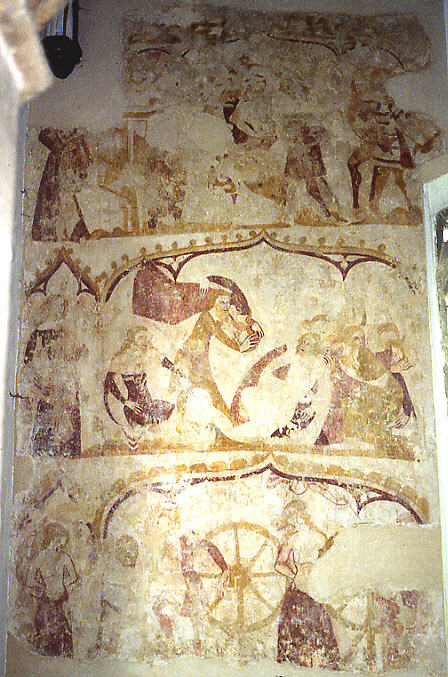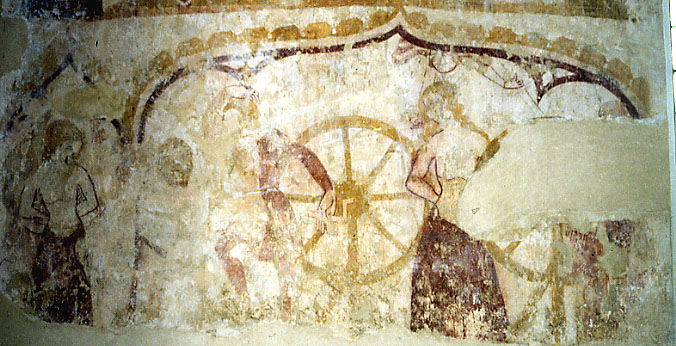Castor, Cambridgeshire (†Peterborough) C.14
The Life of St Catherine

The entire painting, in three tiers, is shown at the right, with an enlarged detail showing Catherine with the wheels below. In 1986/7 Elizabeth Hirst undertook a full restoration, involving the removal of a surface coat of wax from an earlier restoration, the paint layer and the plaster beneath, followed by replacement of the detached painting onto a new lime plaster support. The upper tier is fragmentary, but it is probably an early scene from Catherine’s life, perhaps involving the pagan Emperor Maxentius, who first tried to woo Catherine, then tried to undermine her faith by argument, and finally had her killed.
The clearer scene in the second tier shows the incident involving fifty philosophers ordered by Maxentius to argue Catherine from her faith. Instead, she converted them, and the Emperor had them thrown, unbaptised, into the fire. At the left, Catherine stands under the narrower of two painted canopies above the scene. To her right is the seated Maxentius, making the dramatically downward pointing gesture that sealed the philosophers’ fate. They are shown at the far right, huddled together with the flames rising around them. The standing figure in the centre is difficult to pronounce on. He may be an executioner throwing logs on the fire or holding an upright curved sword to prevent any escape. But above him is a red ochre shape in what looks like a flying posture – this is, perhaps, an angel coming down to confirm the philosophers’ baptism of fire. Below, in the lowest tier, is the best known incident in Catherine’s story, the attempt to break her on the wheel. There are two wheels here, one in the centre and one at the right, and some paintings of Catherine, particularly in manuscripts, have more. Catherine stands once more at the far left, bound and stripped to the waist, with the central wheel further right and an executioner turning the handle. There is what looks like a further, seated, figure, probably Maxentius again, beside him. Catherine is shown again standing between this turning wheel and another at the far right.

Catherine survived this ordeal (she was finally beheaded) because of heavenly intervention. In some versions of her legend, a thunderbolt breaks the wheels, killing bystanders. An imaginative late 15th century interpretation in the Simon Marmion Hours¹ shows the two wheels breaking apart and simultaneously bursting into flames as an angel with a mallet hovers above. An angel in the Castor example is shown just above Catherine’s head, and may be about to intervene in a similar way.
There are no other wall paintings now visible at Castor, but much else of great interest survives from the Middle Ages, including fine Saxon carving. It is the only church in Britain dedicated to St Kyneburgha, a daughter of the stubbornly pagan King Penda of Mercia.
¹ Illustrated in Books of Hours and their Owners, John Harthan, Thames & Hudson, 1977, p. 146 [V&A;, London, Salting Collection, No.1221, fol.15v-16]